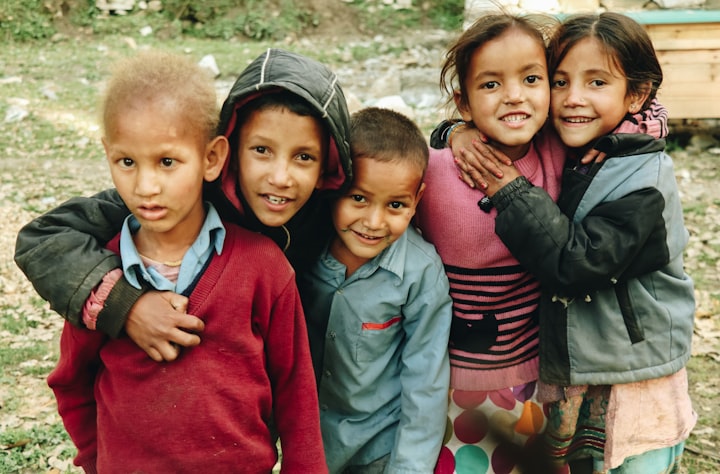Ensuring the rights of vulnerable children
A Path to Empowerment and Equality

Child's rights are an essential aspect of ensuring the well-being, development, and protection of children. The United Nations Convention on the Rights of the Child (UNCRC) is an international human rights treaty that outlines the fundamental rights of children. It sets out a comprehensive framework to ensure the survival, protection, and participation of children in society. Here are some key aspects and topics related to the child's rights:
Right to Life, Survival, and Development: Every child has the inherent right to life, and governments must take appropriate measures to ensure their survival and development to the fullest extent possible.
Right to Education: Children have the right to free and compulsory primary education. Education should be directed towards the development of the child's personality, talents and mental and physical abilities.
Right to Health: Children have the right to access healthcare services, including preventive care, treatment, and rehabilitation. Governments should ensure the provision of necessary healthcare facilities and information.
Protection from Abuse and Exploitation: Children have the right to be protected from all forms of abuse, neglect, violence, and exploitation. This includes protection from child labour, trafficking, and harmful practices.
Right to Identity and Nationality: Every child has the right to a name, nationality, and, as far as possible, to know and be cared for by their parents.
Right to Participation: Children have the right to express their views freely and to have those views taken into account in matters that affect them. They have the right to participate in decisions and processes that impact their lives.
Right, to Play and Leisure: Children have the right to engage in play, recreational activities, and leisure, which are crucial for their physical, mental, and social development.
Right to Protection in Conflict and Emergencies: Children affected by armed conflicts, natural disasters, or other emergencies have the right to special protection, assistance, and support.
Right to a Safe and Nurturing Environment: Children have the right to grow up in a safe and nurturing environment, free from violence, discrimination, and harmful substances.
Rights of Vulnerable Children: Special attention should be given to the rights and needs of children with disabilities, children in alternative care, refugee and migrant children, and children from marginalized communities.
Child labour remains a significant global concern, affecting millions of children worldwide. It is a complex issue that violates children's rights and hinders their development and well-being. In order to address child labour effectively, it is crucial to understand its causes and consequences and implement strategies to eradicate this practice.
Causes of Child Labor:
Poverty and Economic Factors: Poverty is a primary driver of child labour. When families struggle to meet basic needs, children may be forced to work to supplement family income.
Lack of Access to Education: Limited access to quality education, including high costs, inadequate infrastructure, and cultural barriers, can lead children to engage in labour instead of attending school.
Social and Cultural Factors: Social norms, traditions, and gender inequality can perpetuate child labour practices within communities. Certain cultural beliefs may prioritize child labour over education.
Weak Legal Frameworks and Enforcement: Insufficient legislation, weak law enforcement, and corruption contribute to the persistence of child labour, as employers are less likely to face the consequences.
Consequences of Child Labor:
Denial of Education: Child labour deprives children of their right to education, perpetuating a cycle of illiteracy and limited opportunities for social and economic advancement.
Health and Safety Hazards: Child labour often involves hazardous work conditions, exposing children to physical injuries, illnesses, and long-term health issues.
Psychological and Emotional Impact: Child labour can lead to psychological and emotional stress, depriving children of a normal childhood, and impairing their emotional well-being.
Perpetuation of Poverty: Child labour perpetuates the cycle of poverty, as children who are denied education and proper development face limited prospects for economic success in adulthood.
Strategies to Eliminate Child Labor:
Strengthen Legislation and Enforcement: Governments must enact and enforce robust laws and regulations that prohibit child labour and ensure proper penalties for violations.
Universal Education: Governments should prioritize the provision of free and quality education, making it accessible for all children. This includes addressing barriers such as poverty and gender disparities and improving the quality of schools.
Poverty Alleviation and Social Protection: Tackling the root causes of child labour requires comprehensive poverty reduction strategies, including social protection programs that provide financial assistance to families in need.
Awareness and Advocacy: Raising awareness about the detrimental effects of child labour and advocating for the protection of children's rights is crucial. This involves engaging communities, parents, employers, and civil society organizations.
Supply Chain Transparency: Encouraging businesses to adopt responsible and ethical practices throughout their supply chains, ensuring that child labour-free products are produced and sold.
International Cooperation: Collaborative efforts among governments, international organizations, and civil society are essential in addressing child labour global level. This includes sharing best practices and resources and supporting initiatives to combat child labour.
Monitoring and Reporting Mechanisms: Establishing effective monitoring systems and reporting mechanisms to identify and address instances of child labour, ensuring accountability and justice for perpetrators.
Conclusion:
Promoting and protecting children's rights requires a collective effort from governments, organizations, communities, and individuals. By recognizing and upholding these rights, we can ensure that children have the opportunity to thrive, grow, and reach their full potential.
The eradication of child labour requires a multi-faceted approach that addresses its root causes, strengthens legal frameworks, promotes education, and fosters cooperation between various stakeholders. By prioritizing children's rights, investing in education, and addressing poverty, societies can create an environment where children are protected, empowered, and given the opportunity to reach their full potential free from the burden of child labour.





Comments
There are no comments for this story
Be the first to respond and start the conversation.